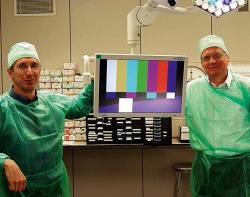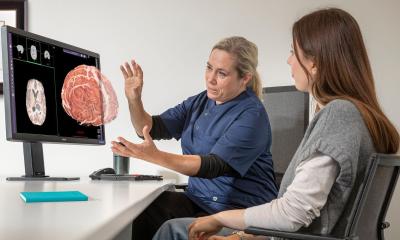Multi-modality HD imaging systems improve visual guidance for minimally invasive surgery
Versatile connectivity and ease-of-use provide a range of benefits to clinicians and surgeons
To modernise the surgical display equipment at Belgium’s foremost university hospitals, NDS Surgical Imaging (NDSsi) has installed Radiance HD surgical displays in the operating theatres and the gastroenterology department. Easy to implement and offering reliable and consistent colour quality, the multi-modality imaging systems addresses the needs of UZ Leuven’s surgeons, clinicians, imaging technologists and technicians


One of Europe’s foremost university hospitals, UZ Leuven, provides top-level medical care and related healthcare services to in- and outpatients from its four sites in the Leuven area, near Brussels. This hospital with 1,995 beds, 47 operating rooms, 49 nursing departments and seven intensive care units serves more than 64,000 inpatients and 111,000 outpatients each year, in more than 635,000 consultations. The workflow is managed by 8,815 employees and clinicians.
Modernizing image guidance and support
‘Because of our size and volumes, it is crucial to consider display systems not as individual devices but as an infrastructure,” says Prof. Erwin Bellon, IT Manager. “We have a growing number of operating theaters, over 50 diagnostic workstations in our diagnostic imaging department, and literally thousands of screens for medical practitioners and clinicians to look at patient images.’ The decision to modernize the existing operating rooms with roofmounted operating lamps provided the impetus to upgrade the medical display equipment as well. ‘We looked for a partner which would allow us to meet the needs of our most demanding internal customers. We soon realized that NDSsi was by far the most experienced partner for us in surgical image guidance and support,’ says Kris Schoonjans, Project Manager, Medical Instrumentation.
Unanimous decision in favor of NDSsi
Kris Schoonjans elaborated that an extensive and user-driven review of the most relevant vendors was undertaken. ‘We organized a doubledisplay setup of each of the vendors in the same room, displayed the same images and asked our clinicians and surgeons to assess the image quality. On all counts, NDSsi came out on top of the user preferences.’ Prof. Dr. Raf Bisschops, Deputy Head of the hospital’s gastroenterology department, was convinced during the trials by the color perception, contrast, and sharpness on the Radiance displays. He was also impressed with the connectivity of the display solutions. ‘We rely on them in our eight examination rooms. The versatile connector panel is key for us: we use three different image generating platforms and the Radiance screens connect to all of them. In particular I appreciate the NDSsi PIP and Swap feature, which allows me to see two sources on a single screen, right in front of me, during confocal endomicroscopy. This speeds up the intervention.’
It is important that imaging technology keeps pace with changing modality technology, Prof. Bisschops continues. As the image-capturing quality of the endoscopic processors improves, display quality needs to improve too. But at the same time, compatibility with all types of image signals must be ensured. ‘It is obvious that the introduction of HD images requires HD displays, but we must still be able to switch between new and historic formats, as well as between composite mode or digital mode, depending on the source’, he says.
Enhanced color accuracy and consistency
The new displays feature the groundbreaking Color Correction Technology, enhancing color accuracy and consistency in surgical video, and the industry’s first stabilized LED backlight, assuring consistent brightness over the life of the display. Kris Schoonjans has high expectations for this new generation of displays. ‘Because we began replacing the screens in sync with the renovation of the operating rooms, a project that takes quite some time, some of our screens are already four years old and may suffer from reduced backlight. This typically is not noticeable in practice unless we replace one screen of a set of two, in which case even small differences in color output become disturbing. Thus, we believe that the new Radiance G2 HD displays will further improve performance.’
Keyhole surgery requires visualization systems that are HD compliant
Thoracic surgery has become primarily a keyhole technology-driven discipline since the introduction of digital camera technologies in the operating theater. UZ Leuven decided to equip all of its operating rooms by default with two Radiance HD displays. This allows surgeons to work in any room with their preferred video tower and enjoy the same display configuration and image quality. Thoracic surgeon Dr. Herbert Decaluwé recently joined the UZ Leuven thoracic surgery team. For him, the availability of High- Definition visualization systems is a major advantage. ‘High-Definition makes all the difference. With keyhole interventions, you miss tactile feedback from direct contact with the patient; so visual feedback onscreen becomes even more crucial. HD cameras and displays allow us to enlarge images so that you can actually see more than with open surgery. It’s great to have this technology at hand.’
Enhanced technical comfort for technicians
From a technical perspective, NDSsi’s Radiance HD surgical displays offer a level of user comfort that is unparalleled, says Kris Schoonjans. He particularly appreciates the quality default settings of the displays. ‘Unlike other vendors, with NDSsi we do not need to adapt or calibrate the color settings when installing the displays. That saves us a lot of time and guarantees perfect display quality from the start.’ The ability to connect to many diverse sources, enabling simultaneous viewing of real-time video, fluoroscopic, ultrasound, or vital sign imaging is also important. The in-out connectors allow to connect a source from one screen directly in cascade to additional displays, without the need for a splitter. ‘It’s a very useful feature when using cameras that have only a single output’, says Kris Schoonjans.
Connectivity of displays is key, both now and in the future
Along with Prof. Bellon, Kris Schoonjans emphasizes the continuity that NDSsi and its local distributor have provided throughout the execution of the contract. ‘We have seen displays move from the CRT model to flat screen, and from 19” screens with a 4:3 ratio to a 16:9 format. In spite of these important developments, we still have the choice between all sizes of screens from 19” to 55”. And all this time, the display user interface has remained unchanged.’ Both view NDSsi as a valuable partner, who will keep abreast of developments and future trends in medical imaging, particularly in the surgical fields. ‘We chose an infrastructure solution from a responsive partner that could also help us anticipate future trends. Connectivity of the displays is proving to be even more important than we could have imagined five years ago and we are convinced that with NDSsi we will stay abreast of technological developments.’
12.11.2012











